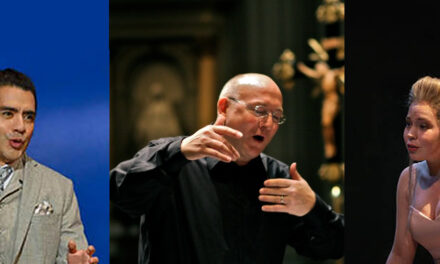Professor Ida Bieler of the UNC School of the Arts and of the Robert Schumann University of Music and Media in Düsseldorf (Germany) joined Provost David Nelson of UNCSA in a performance of and lecture on two unaccompanied works for violin by Johann Sebastian Bach in the neo-Gothic stone home of St. Paul’s Episcopal Church. Ms. Bieler is a fine violinist with beautiful tone, near-perfect intonation, and an admirably expressive approach to phrasing and musical architecture.
The format of this event was sufficiently different from a usual musical performance that I permit myself the indulgence of a philosophical observation or two as well as a musical review.
The sources of artistic inspiration are so numerous as to be infinite. From the mystic revelations of universal truths to the carnal impulses of sensuous love, artists have been able “to see a world in a grain of sand.” The human universe is replete with systems and examples of iconography, symbolism, allusion, transformation, metamorphosis, and references to entities and ideas in other spheres. So we look at a Renaissance painting of the Annunciation and see the gate (hortus closus) in the background as a symbol of Mary’s virginity, the lily in the angel’s hand a symbol of purity, and the dove riding a beam of light to her ear as the visitation of the Holy Ghost. Or we hear fate knocking on the gate while listening to Beethoven’s Fifth Symphony. To some, the white whale is a symbol of evil and to others, the symbol of unconquerable Nature. To one author, red may symbolize passion and black anarchy; to another, red clergy and black secularism. Wet and dry are symbols of fertility and infertility to T.S. Eliot, or perhaps of death.
Rare is the composer who has not used an extra-musical source or symbol in a purely musical context. Recent scholarship attributes the sudden starts and stops in late Beethoven to cardiac irregularities he lived with and possibly transferred to his music. Mozart and Haydn used certain keys when composing music to celebrate Masonic rites. Schumann wrote whole sets of variations using a friend’s name transferred to music (ABEGG). Wagner assigned specific themes to the characters in his mythological operas (Leitmotifs).
The microcosmic cruciform musical motifs “B-flat, A, C, B-natural” and “D, E-flat, C, B-Natural” are cryptograms of two celebrated composers’ last names – Bach and D. S(c)hostakovich – and figure prominently in their compositions. Indeed, Bach, in his masterful B Minor Mass, places the Crucifixion moment in the exact center of the entire work, symmetrically, so as to divide the Mass into the shape of a cross, a macrocosmic use of the cruciform.
Numerologists (people who assign numerical values to letters or musical notes) will often find relationships between composers’ names and musical themes. Several such relationships were identified and presented by the well-spoken Provost Nelson as he introduced first the Bach Sonata No. 2 in A minor, S.1003, and then the Partita No. 2, S.1004, with its famous Chaconne. It is clear that these numerological relationships are not coincidences – they are too specific and elaborate to be accidents! The question becomes one of the importance of these relationships to the performer and to the listener. It seems clear that they are of great importance to the composer and to the composer’s state of mind when these works were being composed. And no doubt they can contribute to the understanding by the performer. But it is doubtful that they contribute much to the understanding of the listener, who could only become conscious of the relationships after study or being informed of them. For more about Iconography and Bach’s B Minor Mass, see here. More about the Bach Sonatas and Partitas can been found here.
The second Partita is a set of five dances, starting with a serious and sober Allemanda, followed by a scurrying Courante. The Sarabande, in a stately triple meter, with its typical doted rhythm, almost predicts the final movement but is separated from it by the Gigue, which Ms. Bieler started in an intentionally hesitant manner, then letting it pick up vigor and energy. And she attacked the final chaconne without the pause I anticipated.
The Chaconne (originally in Italian “Ciaccona”), the final movement of the Second Partita, may well have been composed as a loving tribute to Bach’s suddenly deceased wife, Maria Barbara Bach, the numerological value of whose name (95) is the same as the numerological value of the 17 notes of the opening theme of the Chaconne. (The chaconne form is in itself strict, a set of 16, 24, or 32 – or more – variations in a triple meter.) Regardless of the personal context of the composition, this work is an apex of music and was the much-anticipated climax of the entire evening. And the performance exceeded expectations – greatly! Variations in tempo and dynamics flowed naturally and expressively. The mid-section, in D Major, was an island of repose and infinitely sweet before the final statement of the original theme closed the profound moment of peaceful sorrow. The appreciative audience applauded long and somberly before Prof. Bieler’s students started cheering in typical youthful fashion.











